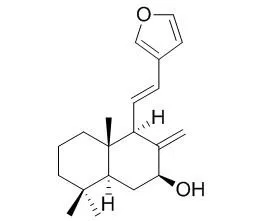| In vitro: |
| Chem Pharm Bull (Tokyo). 2012;60(2):246-50. | | Labdane-type diterpenoids from the rhizomes of Hedychium coronarium inhibit lipopolysaccharide-stimulated production of pro-inflammatory cytokines in bone marrow-derived dendritic cells.[Pubmed: 22293485] | The rhizomes of Hedychium coronarium have been used for the treatment of inflammation, skin diseases, headache, and sharp pain due to rheumatism in traditional medicine.
METHODS AND RESULTS:
From this plant, two new labdanes, 15-methoxylabda-8(17),11E,13-trien-16,15-olide (1) and 16-methoxylabda-8(17),11E,13-trien-15,16-olide (3), named hedycoronens A and B, as well as four known, labda-8(17),11,13-trien-16,15-olide (2), 16-hydroxylabda-8(17),11,13-trien-15,16-olide (4), Coronarin A (5), and corronarin E (6) were isolated. Their chemical structures were elucidated by mass, 1D- and 2D-nuclear magnetic resonance (NMR) spectroscopy. They were evaluated for inhibitory effects on the lipopolysaccharide (LPS)-stimulated production of pro-inflammatory cytokines in bone marrow-derived dendritic cells.
CONCLUSIONS:
Among of them, compounds 1-3 were potent inhibitors of LPS-stimulated interleukin-6 (IL-6) and IL-12 p40, with IC(50) ranging from 4.1±0.2 to 9.1±0.3 μM. Compounds 1 and 3 showed moderate inhibitory activity on the tumor necrosis factor-α (TNF-α) production with IC(50) values of 46.0±1.3 and 12.7±0.3 μM. The remains of compounds showed inactivity.
These results warrant further studies concerning the potential anti-inflammatory benefits of labdane-diterpenes from H. coronarium. | | Phytother Res. 2010 Jul;24(7):1009-13. doi: 10.1002/ptr.3057. | | Labdane-type diterpenes from Hedychium gardnerianum with potent cytotoxicity against human small cell lung cancer cells.[Pubmed: 19960422] |
METHODS AND RESULTS:
Seven labdane-type diterpenes, coronarin E, Coronarin A, yunnanCoronarin A, yunnancoronarin B, hedyforrestin B, villosin, and hedyforrestin C were isolated from the rhizome of Hedychium gardnerianum and evaluated for cytotoxic activity against human small cell lung cancer (NCI-H187) and non-cancerous Vero cells. The results showed that villosin exhibited potent cytotoxic activity with IC(50) of 0.40 microM, which was higher than that of the drug ellipticine (IC(50) 1.79 microM). Moreover, ellipticine was very toxic to Vero cells (IC(50) 7.47 microM) whereas the toxicity of villosin was undetectable at concentration lower than 166.42 microM.
CONCLUSIONS:
The results have indicated that the lactone ring is essential for high cytotoxic activity and that the presence of a hydroxyl group at the 6 or 7 position causes decrease in activity. The very high cytotoxicity against the NCI-H187 cells and the exceptionally high selectivity index (>416) of villosin suggested that this compound may be used as a potential lead molecule for antitumor therapeutic development. | | Planta Med., 2011, 77(12):1344-1344. | | New labdane-type diterpenoids and anti-inflammatory constituents from the rhizome of Hedychium coronarium[Reference: WebLink] |
METHODS AND RESULTS:
Hedychium coronarium J.Koenig (Zingiberaceae) is a terrestrial epiphytic herb, which is distribution in India, Malaysia, Vietnam, southern China and Taiwan [1]. Two new labdane-type diterpenoids, hedychicoronarin (1) and peroxycoronarin D (2), together with eleven known compounds, including calcaratarin (3), (+)-Coronarin A (4), coronarin D (5), coronarin D methyl ether (6), (E)-labda-8(17),12-diene-15,16-dial (7), ergosta-4,6,8(14),22-tetraen-3-one (8), β-sitostenone (9), stigmasta-4,22-dien-3-one (10), oleic acid (11), stearic acid (12), and palmitic acid (13) have been isolated from the rhizomes of Hedychium coronarium. The structure of new compounds 1 and 2 was determined through spectral analyses including extensive 2D NMR data.
CONCLUSIONS:
Among the isolates, calcaratarin (3), Coronarin A (4), (E)-labda-8(17),12-diene-15,16-dial (7), and oleic acid (11) exhibited potent inhibition (IC50 <6.17μg/mL) against fMLP-induced superoxide production and elastase release. |
|






 Cell. 2018 Jan 11;172(1-2):249-261.e12. doi: 10.1016/j.cell.2017.12.019.IF=36.216(2019)
Cell. 2018 Jan 11;172(1-2):249-261.e12. doi: 10.1016/j.cell.2017.12.019.IF=36.216(2019) Cell Metab. 2020 Mar 3;31(3):534-548.e5. doi: 10.1016/j.cmet.2020.01.002.IF=22.415(2019)
Cell Metab. 2020 Mar 3;31(3):534-548.e5. doi: 10.1016/j.cmet.2020.01.002.IF=22.415(2019) Mol Cell. 2017 Nov 16;68(4):673-685.e6. doi: 10.1016/j.molcel.2017.10.022.IF=14.548(2019)
Mol Cell. 2017 Nov 16;68(4):673-685.e6. doi: 10.1016/j.molcel.2017.10.022.IF=14.548(2019)